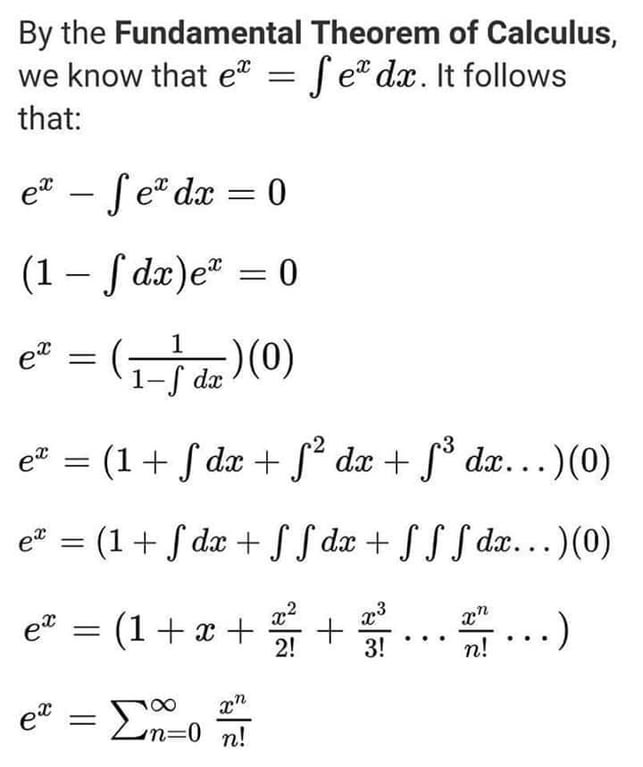this post was submitted on 22 Jan 2024
128 points (100.0% liked)
Math Memes
2840 readers
1 users here now
Memes related to mathematics.
Rules:
1: Memes must be related to mathematics in some way.
2: No bigotry of any kind.
founded 2 years ago
MODERATORS
you are viewing a single comment's thread
view the rest of the comments
view the rest of the comments

Except the first assumption that e^x = its own integral, everything else actually makes sense (except the DX are in the wrong powers). You simply treat the "1" and "integral dx" as operators, formally functions from R^R into R^R and "(0)" as calculating the value of the operator on a constant-valued function 0. EDIT: the step 1/(1-integral) = the limit of a certain series is slightly dubious, but I believe it can be formally proven as well. EDIT 2: I was proven wrong, read the comments
is it immediately obvious that the inverse of the operator L is 1/L though? Much less the series expansion for the operator...
If you try to fill in the technical details it will be a lot of work compared to a simpler calculus based alternative
But then again some Mathematicians spent the better half of the century formalizing the mathematics used by Physicists like Dirac (spoiler: they all turned out to be valid)
After careful consideration I have come to the conclusion that the inverse of the operator L is obviously not 1/L and you are absolutely right. This derivation is complete nonsense, my apologies. In fact no such inverse can even exist for the operator 1 - integral, as this function is not an injection.
What is meant here, I believe, is (1 - Int)^-1. Writing 1/(1 - Int) is an abuse of notation, especially when the numerator isn't just 1 but another operator, which loses the distinction between a left and a right inverse. But for a bounded linear operator on a normed vector space, and I think Int over an appropriately chosen space of functions qualifies, (1 - Int)^-1 equals the Neumann series \sum_k=0^∞ Int^k, exactly as in the derivation.
Int is injective: Take Int f = Int g, apply the derivative, and the fundamental theorem gives you f = g. I think you can make it bijective by working with equivalence classes of functions that differ only by a constant.
Int is definitely not injective when you consider noncontinuous functions (such as f(X)={1 iff X=0, else 0}). If you consider only continuous functions, then unfortunately 1-Int is also not injective. Consider for example e^x and 2e^x. Unfortunately your idea with equivalence classes also fails, as for L = 1 - Int, L(f) = L(g) implies only that L(f-g) = 0, so for f(X)=X and g(X)=X + e^x L(f) = L(g)
Sets of measure zero are unfair. But you're right, the second line in the image is basically an eigenvector equation for Int and eigenvalue 1, where the whole point is that there is a subspace that is mapped to zero by the operator.
I'm still curious if one could make this work. This looks similar to problems encountered in perturbation theory, when you look for eigenvectors of an operator related to one where you have the spectrum.
Well, sets of measure 0 are one of the fundamentals of the whole integration theory, so it is always wise to pay particular attention to their behaviour under certain transformations. The whole 1 + int + int^2 + ... series intuitively really seems to work as an inverse of 1 - int over a special subspace of R^R functions, I think a good choice would be a space of polynomials over e^x and X (to leave no ambiguity: R[X, e^X]). It is all we need to prove this theorem, and these operators behave much more predictably in it. It would be nice to find a formal definition for the convergence of the series, but I can't think of any metric that would scratch that itch.
That's the thing about physicists doing math. They know the universe already works. So if they break some math on the way to an explanation, so what? You can fix math. They care about the universe. It's pretty cool sometimes. Like bra-ket notation is really an expression the linear algebra concepts of dual space and adjoints. But to a physicist, it's just how the math should work if it is to do anything useful.
So yeah, this post looks like nonsense. Because it is. But there is a lesson that "math" should work like this, and there is utility in pushing the limits. No pun intended.
Edit: I'm not claiming this is a useful application. It's circular reasoning as this post's parent alludes to.
If you "fill in" the indefinite integral with a (definite integral with) bounds -infinity to x, then I think the first step works. I'm not 100% how to deal with the 1/(1-integral) step, but my guess would be to transform to the Laplace domain because Laplace transform analysis is "aware of" convergence issues, i.e. the region of convergence "pops out" when calculating the transform, or it's present in the lookup table entry.